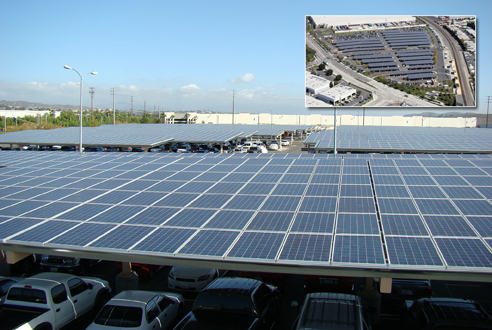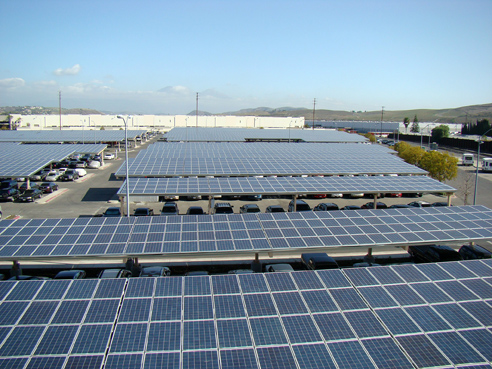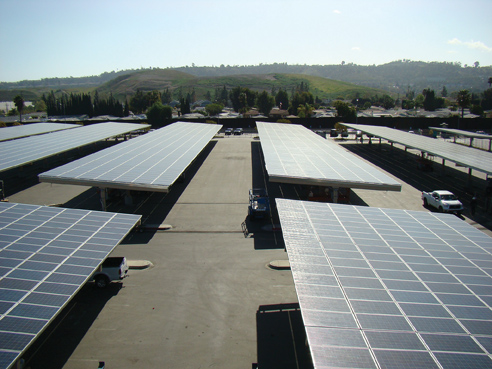Back Issues
City of industry moves into solar futureThe futuristic sounding City of Industry, just outside Los Angeles, is moving into the future with a solar carport and electric vehicle charging station project, the largest of its kind in southern California. By
Tony Kryzanowski
The futuristic sounding City of Industry has just completed the Metrolink Public Transportation Station 2 megawatt (MW) solar PV carport and electric vehicle (EV) charging station project. The city is located east of Los Angeles following Interstate Highway 60. Dedicated primarily to industrial development, such as warehousing and manufacturing, City of Industry has a mayor but very few residences. The city is also home to the Metrolink Public Transportation Station, which allows commuters from surrounding communities to park their vehicles and board trains bound for downtown Los Angeles and the San Bernardino/Riverside area. The solar power and electric vehicle plug-in carport project has resulted in the installation of 8,372 stationary solar panels that are situated to provide much needed shade for vehicles using 940 of the carport's stalls. It is the largest project of its kind in Southern California and is generating revenue for the city through the sale of renewable power. Among the parking stalls are 64 charging stations for electric vehicles. A portion of the 2 MWs per hour of power generated by the solar panels (and sold by City of Industry under a 20-year power purchase agreement to Southern California Edison) is channeled back to the charging stations through the power grid. A strong motivator for Southern California Edison to participate in the project was a requirement by the California Public Utilities Commission for it to achieve 30 percent power production from renewable energy. As a result of that requirement, the power company put out an Independent Power Producer (IPP) Request for Offers, looking for potential sellers of renewable power to the utility. The City of Industry was among the successful applicants with its carport solar power project. One of the knocks against today's electric-powered vehicles is the short distance they can travel before they require recharging—usually in the range of 100 to 200 miles. The Metrolink Public Transportation Station charging stalls will provide electric vehicle commuters the opportunity to recharge their vehicles while they are in Los Angeles. Because the station is within a mile from two major freeways, individuals typically use the carport and train station to commute to jobs in Los Angeles. City of Industry Mayor Dave Perez says that electric vehicle owners will be able to swipe a credit card to pay for the power their vehicles consume while they are using the recharging stations. However, at this early stage, the city is not charging for the use of the recharging stations. The power generated by the solar panels will provide significantly more than just the power needed for the recharging stations. According to Southern California Edison, the 2 MWs per hour provide enough power for 1300 homes for one hour. To pay for the $11 million cost of the project, City of Industry tapped into funds collected under the state's Proposition A initiative. Proposition A funds derive from a half cent sales tax that Los Angeles County collects to generate money for transportation projects.
Whittier, California-based, OltmansConstruction was the main contractor on the City of Industry Metrolink carport project. Company vice-president Tony Perez (no relation to the City of Industry mayor) says the solar power and vehicle recharging station project is a reflection of the future in several ways. First, more people in California are using electric vehicles. Second, there are a growing number of businesses that are establishing vehicle recharging stations in retail locations, near office buildings, and along major commuter highways in Southern California. And third, companies like OltmansConstruction have recognized the growing number of opportunities to bid on renewable energy projects like the City of Industry project, which specifically use existing carports and rooftops as infrastructure for the installation of solar power generation. It has become a big part of their business plan. "We've done quite a lot of rooftop solar work here in the Southern California market on warehouses," says Perez. "We started that division in 2009 and have completed about $100 million worth of work in two years." He adds that it continues to be an expanding market. The City of Industry project was their first involving a carport, although some of their sub-contractor team members have experience installing solar panels on military base carports. The two main sub-contractorsOltmans worked with on this project were Panelized Solar Inc. for installation of the solar energy modules and Gregg Electric Inc., the main electrical contractor. "Gregg Electric and Oltmans have done 38 megawatts of rooftop solar over the past two years, so we know what requirements we have to meet to get the job done," says Perez. While he has noticed a considerable improvement in air quality in the Los Angeles area during his years growing up there, he says there is no doubt that greater use of electric vehicles will help improve air quality even more. Prior to the installation, the Metrolink infrastructure consisted of a paved parking lot with 1200 stalls and the train station. Perez says that having a paved site to start with was an overall benefit in building the carport. Oltmans constructed the carport on the parking lot, consisting of a foundation and columns that support the solar panels.
|











